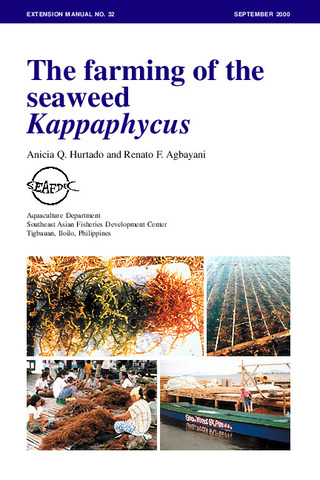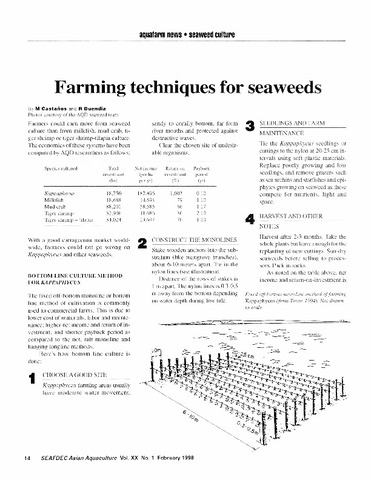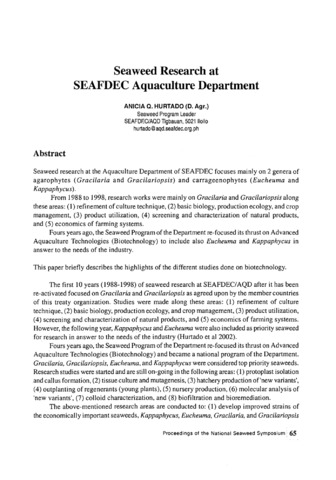| dc.contributor.author | Sibonga, Rema | |
| dc.contributor.author | Brakel, Janina | |
| dc.contributor.author | Gachon, Claire | |
| dc.contributor.author | Faisan, Jr., Joseph | |
| dc.contributor.author | Brodie, Juliet | |
| dc.contributor.author | Ward, Georgia | |
| dc.contributor.author | Ferriols, Victor Marco Emmanuel | |
| dc.contributor.author | Luhan, Maria Rovilla | |
| dc.contributor.author | Hurtado, Anicia Q. | |
| dc.contributor.editor | Ferrer, Alice Joan | |
| dc.coverage.spatial | Iloilo | en |
| dc.coverage.spatial | Guimaras | en |
| dc.coverage.spatial | Bohol | en |
| dc.coverage.spatial | Philippines | en |
| dc.date.accessioned | 2023-03-10T07:11:22Z | |
| dc.date.available | 2023-03-10T07:11:22Z | |
| dc.date.issued | 2022 | |
| dc.identifier.citation | Sibonga, R. C., Brakel, J., Gachon, C. M. M., Faisan, Jr., J. P., Brodie, J., Ward, G., Ferriols, V. M. E. N., Luhan, M. R. J., & Hurtado, A. Q. (2022). Characterization of wild eucheumatoids from Visayas, Philippines as inferred from the mitochondrial cox2-3 spacer sequence. In A. J. G. Ferrer (Ed.), Proceeding of Joint International Conference of the Sixth International Conference on Fisheries and Aquatic Sciences (ICFAS 6) and Asian Fisheries Social Science Research Network Forum One (AFSSRN F1), 24-26 November 2021, via Zoom, Miagao, Iloilo, Philippines (pp. 82–88). University of the Philippines Visayas. | en |
| dc.identifier.isbn | 9786218285125 | |
| dc.identifier.uri | http://hdl.handle.net/10862/6417 | |
| dc.description.abstract | Eucheumatoids are the major seaweed species cultivated in most coastal areas in the Philippines, being a major source of income for many families. Seaweed farmers face issues such as lack of good quality cultivars and the presence of diseases and epiphytes in the cultivated stocks. This study characterizes the wild eucheumatoids, which are potential sources of cultivars that might be resistant to diseases and epiphytes. Wild eucheumatoids were collected from Iloilo (N=18), Guimaras (N=10), and Bohol (N=20), Philippines. Gross morphology was described, and a 10-mm apical tip was excised for DNA extraction. PCR amplification and sequencing using cox2-3 spacer genetic markers were done. Based on sequence data, 5 species can be identified from the Visayas region: the commercially cultivated Kappaphycus alvarezii (Iloilo, Bohol), K. striatus (Iloilo, Guimaras), and Eucheuma denticulatum (Iloilo, Bohol) and the currently uncultivated K. cottonii (Iloilo) and Kappaphycus sp. (Iloilo, Bohol). Haplotype network analysis identifies individuals of K alvarezii and E. denticulatum as haplotype E3 and E13, respectively, which are haplotypes previously reported from seaweed farms and globally distributed for cultivation purposes. The K. striatus from Iloilo and Guimaras are identified as haplotype E89, and the K. cottonii from Iloilo is haplotype E108 which has been described previously from seaweed farms and wild populations, respectively. Interestingly, Kappaphycus sp. from Iloilo and Bohol are identified as haplotype GUI1 initially described in 2014 and yet to be identified up to the species level. Our study shows that purely morphological identification is not sufficient to reliably identify species, thus highlighting the need to employ molecular techniques supporting strain selection. In summary, it reveals a rich diversity of wild eucheumatoids in the Visayas region of the Philippines. In-vitro studies need to reveal the performance of individuals from these wild populations but highlight a great potential for the development of new cultivars. | en |
| dc.description.sponsorship | The authors would like to acknowledge the United Kingdom Research and Innovation and Global Challenges Research Fund for the funding, as well as their UK partners, namely, the Scottish Association for Marine Science, the Natural History Museum, the Centre for Environment, Fisheries and Aquaculture Science and the Overseas Development Institute. The authors also thank their partners from the United Nations University in Belgium, the University of Malaya in Malaysia, the University of Dar es Salaam in Tanzania, and the Southeast Asian Fisheries Development Center Aquaculture Department for their contributions during the implementation of this study. | en |
| dc.language.iso | en | en |
| dc.publisher | University of the Philippines Visayas | en |
| dc.subject | Kappaphycus alvarezii | en |
| dc.subject | Eucheuma denticulatum | en |
| dc.title | Characterization of wild eucheumatoids from Visayas, Philippines as inferred from the mitochondrial cox2-3 spacer sequence | en |
| dc.type | Conference paper | en |
| dc.citation.spage | 82 | en |
| dc.citation.epage | 88 | en |
| dc.subject.asfa | seaweeds | en |
| dc.subject.asfa | seaweed culture | en |
| dc.subject.asfa | morphology | en |
| dc.subject.asfa | genetic variation | en |
| dc.citation.conferenceTitle | Proceeding of Joint International Conference of the Sixth International Conference on Fisheries and Aquatic Sciences (ICFAS 6) and Asian Fisheries Social Science Research Network Forum One (AFSSRN F1), 24-26 November 2021, via Zoom, Miagao, Iloilo, Philippines | en |
| dc.subject.scientificName | Kappaphycus alvarezii | en |
| dc.subject.scientificName | Kappaphycus striatus | en |
| dc.subject.scientificName | Eucheuma denticulatum | en |
| dc.subject.scientificName | Kappaphycus cottonii | en |
| dc.subject.scientificName | Kappaphycus | en |
| local.subject | eucheumatoids | en |
| local.subject | haplotype | en |
| local.subject | ox2-3 spacer | en |



